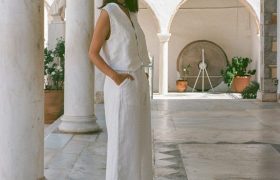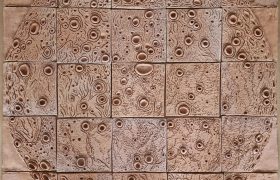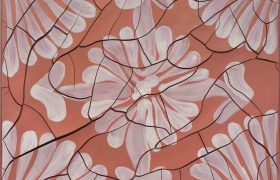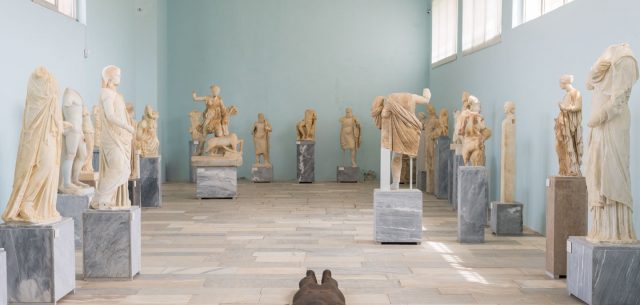Onassis and Niarchos – A duel in the sun
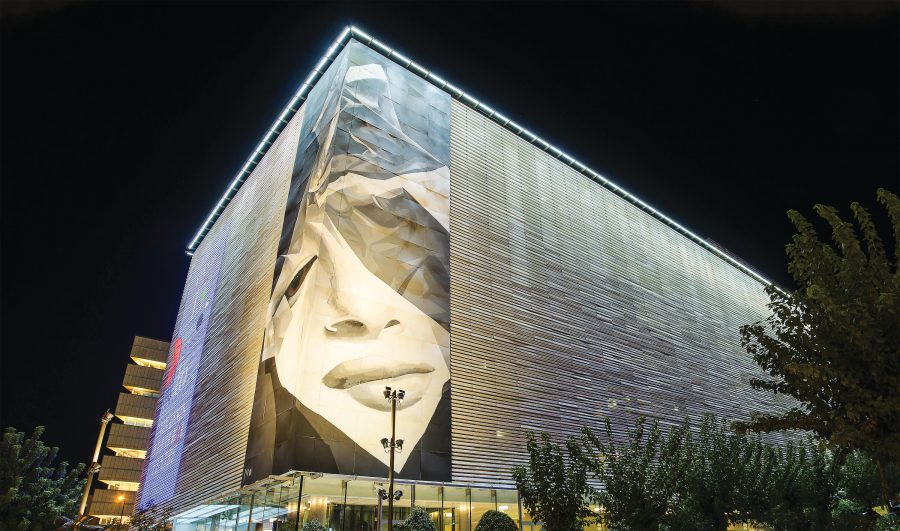
Onassis Cultural Centre
Unrelenting rivals in life, global shipping magnates and early proponents of the glam0urous, jet-setting, luxury lifestyle that came to define their generation, Aristotle Onassis and Stavros Niarchos continue to perpetuate their rivalry posthumously. Their formidable cultural institutions aspire to revolutionize Athens as an artistic destination, inadvertently shifting the city’s cultural epicentre towards the sea, Alexia Kefalas notes.
In the maelstrom of Syngrou Avenue traffic, which connects Athens to the port of Piraeus, two impressive buildings stand out. They symbolize modernity and openness, reflecting a new image for Athens: that of a cultural destination par excellence. The first, the Onassis Foundation, also called Stegi, ‘roof’ in Greek, houses ‘the arts and letters’. The building is constructed from a huge block of Thassos marble with neon lettering on its facade that reads: ‘All we have are words, all we have are worlds.’ The second, the Stavros Niarchos Cultural Foundation – SNFCC, is a haven of peace nestled in the Faliro Delta, just off the noisy avenue. It welcomes visitors with a canal filled with sea-water, as if to announce its proximity to the coast, and a sumptuous Mediterranean garden of olive trees and cypresses, that surround a colossal building housing the National Opera and the brand-new National Library.
The Onassis Cultural Center was founded in 2010, funded by the shipping magnate’s Onassis Foundation, but is now run by a board of directors unconnected to Aristotle’s granddaughter and heiress Athina. Just a few hundred meters away and seven years later, the Niarchos Foundation was inaugurated, financed by the Niarchos family at a cost of 630 million euros. Unlike the Onassis Cultural Center, it was gifted to the State, which administers it in collaboration with the Niarchos Foundation.
Both cultural institutions had the boldness to emerge in the midst of Greece’s economic crisis and succeeded in bringing about a cultural revival and an upswing for Greece’s soft power. In visiting these wonderfully designed temples of culture, that have been fully embraced by Greeks, it is hard not to think of their founders, whose lives and ambitions mirrored each other.
Their epic saga
In the 1940s, Aristotle Onassis and Stavros Niarchos were two budding Greek shipowners in New York, whose rivalry had already kicked off, both professionally and personally. They both toiled to make their mark in the shipping industry, while trying to draw the attention of Athina (Tina) Livanos.
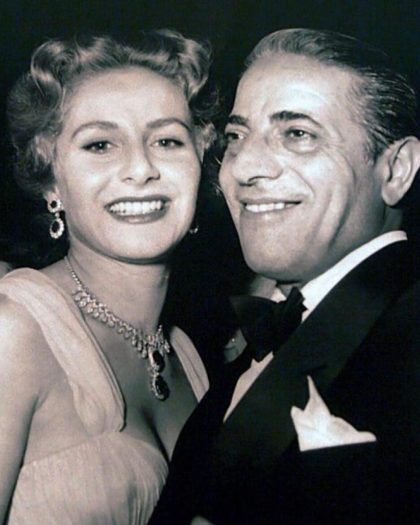
Aristotle Onassis with
Athina Livanos
This teenager with movie-star good looks, was coveted by both men. She was the daughter of the patriarch of the Greek diaspora’s shipowners – Stavros Livanos. At the age of 40, (Tina was just 17 then), it’s Aristotle Onassis who seals the deal by convincing Tina’s father that he was the one for her. Shortly after Aristotle’s marriage to Tina, Stavros Niarchos agrees to marry Tina’s older sister, Eugenia.
Peter Evans’ revelatory biography on Onassis is a study on jealousy, love, money and power, capturing the extent of the fierce competition between the two shipowners: “When Niarchos appeared on the cover of ‘Time’ magazine, Evans recalled, Onassis did everything to have his own. Onassis owned the yacht ‘Christina’, Niarchos, ‘Kreoli’. Onassis bought and transformed the island of Skorpios into a small private paradise, while Niarchos did the same with Spetsopoula Island. When Onassis received Greta Garbo, Niarchos welcomed Rudolf Nureyev. Aristotle marries the widow of the President of the United States, Stavros fathers a child with Charlotte Ford, daughter of the automobile magnate.”
After her sister Eugenia’s mysterious death, Tina (already divorced by then for 10 years from Onassis) hastens to marry her brother-in-law, Niarchos; something Onassis and his daughter Christina never forgave her for. Today, Athina Onassis, Aristotle’s granddaughter, has little connection with her cousins Stavros and Eugenie, both of whom lead diametrically opposed lives. Athina lives a private and quiet life, while the Niarchos siblings seem to enjoy the spotlight and celebrity.
The differences in the character of these two antagonistic families are reflected in the architectural design of the two foundations that bear their names. It is little coincidence that the construction of the Niarchos Foundation began just a few days after the inauguration of the Onassis Center. The Stegi is a seemingly austere building on the outside, almost barricaded, in contrast with the size of the two auditoria and the transparency of the building inside. The Niarchos Foundation, on the contrary, spreads over more than 210,000sqm with 170 hectares of landscaped parkland.

Stavros Niarchos with
Athina Livanos
Christos Carras, the artistic director of the Onassis Cultural Center, explained that the imposing structure of the Onassis Center was designed by Architecture Studio “who designed the building of the European Parliament.” The SNFCC was the vision of Renzo Piano, whose other architectural landmarks include the Centre Pompidou in Paris.
Discovering these different worlds, under the shadow of their founders’ history, drives home the influence wielded by shipowner families in their native land.
According to Ilias Tzempetonidis, Casting Director for the Paris Opera, who has worked in Greece for years, this tradition of philanthropy is a great opportunity for Greece. “In antiquity,” he explains, “the practice was that the richest in the city should also be its benefactors. These so-called benefactors were patrons of cultural activities.” He believes that these two cultural institutions complement rather than compete with one another, whilst creating a unique challenge for the country, “to position itself on the international scene in educational and cultural matters”. That is precisely what these new temples must hope to accomplish.
Different approaches to culture
Christos Carras, who followed the construction of the Onassis Cultural Center from its very beginning, explains that “since the building was designed, the centre’s programming has changed: it was meant to be classic and institutional, it is in fact, totally avant-garde”. Once inside, you have the impression of being aboard a luxury liner, the steps in bluish glass look like waves – an allusion to Aristotle Onassis, who wanted to be the king of the seas. Christos Carras is fascinated by the contrast offered by the interior and exterior of this building:
“The marble, which is a very classical material for the Greeks, is used in a modern way, with minimalist lines that frame the building outside. Inside, everything is, on the contrary, alive and warm, with games of transparency and light. In the daytime, you cannot see what is going on inside, but at nightfall, as soon as the lights come on, it’s a guessing game for the passer-by on what might transpire here!”
He adds, “We are the only ones working on current, contemporary, interdisciplinary and international creations. The Onassis Foundation has been working for forty-five years in the field of health, education and culture. We have a scholarship and research support programme, but since the creation of the Cultural Center in 2010, the Foundation has been focusing more on contemporary culture.” From performing arts, debates, visual and digital arts, to music and drama, the idea is to provide a high-level technical platform, and to work with other institutions abroad.
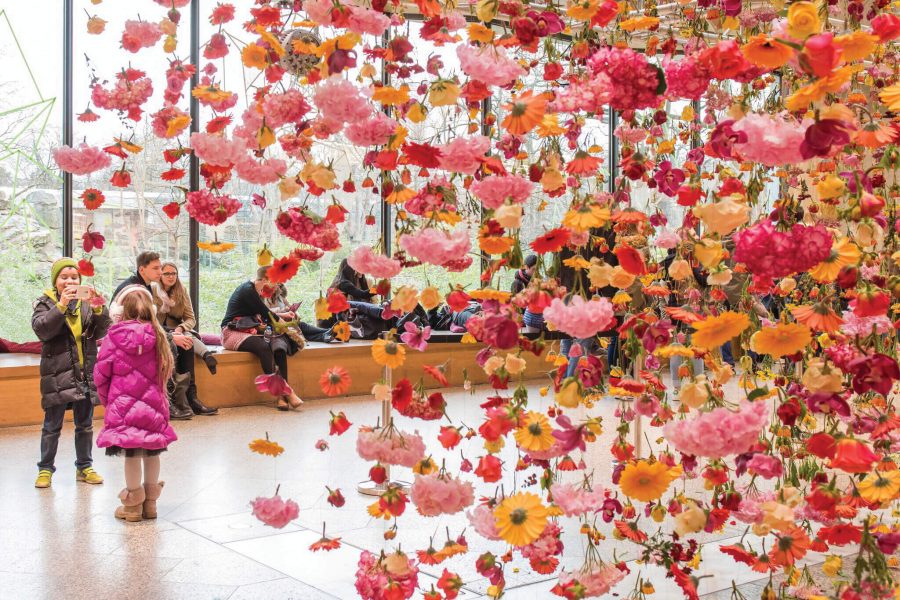
Flower installation by Rebecca Louise Law at the Onassis Cultural Center
Like its building, the Onassis Cultural Center’s approach to culture is urban and conceptual; the polar opposite of the Niarchos Foundation which focuses on the ecological aspect, with programmed shows accessible to the public for free.
Giorgio Bianchi, Renzo Piano’s architect partner, spent eight years at the Niarchos Foundation’s construction site. “It was a unique adventure,” he says of his time in Athens.
“Each architectural project changes the future of the city. Part of our mission was to improve the life of the city and its inhabitants. To create this building, we smelled the atmosphere, listened to the sounds of the city for hours. One of the most delicate points was to build, on this flat land by the sea, a hill that matches the shape of the building. And on the hill, to install photovoltaic panels that can supply energy to a part of the building, then draw below the building in several areas, to play with natural light. ”
The city beneath the city
Their task was made all the more complex by, the discovery of a necropolis with more than a thousand graves, during the archaeological excavations that preceded the construction. This find paved the way for an invaluable study of anthropological data on diseases, nutritional deficiencies, life expectancy, and social classes.
Especially important was the April 2016 unearthing of eighty aligned skeletons belonging to the young aristocrats who participated in Cylon’s failed coup, at the end of 700 BC. Their death sentence was by crucifixion, with their wrists attached by handcuffs to wooden boards. Thucydides writes that this former Olympic champion, had attempted, with the help of his father-in-law, the tyrant Theagenes of Megara, to seize power from the city’s Archons (magistrates). The Archons stopped Cylon and forced him and his followers to retreat and take cover at the Temple of Athena. Cylon and his followers were persuaded by the Archons to leave the temple and stand trial, as they were promised their lives would be spared if they appeared in court. However, shortly after Cylon and his men left the temple, they were executed. When the bodies of the victims were exhumed at the beginning of the twentieth century, the discovery caused a scandal: how could the Athenians, who conceived the idea of democracy, use such barbaric methods? The leading archaeologist was almost lynched, and the excavations were interrupted.
Passions have now subsided and Stella Chryssoulaki, Ephorate of Antiquities for Piraeus, who led the excavation project, was able to complete the examination of the battered remains lined-up in a mass grave in three parallel rows, “they were young men, 20-25 years old, and in good health” she noted. “There were even two children, between the ages of 12-14.” The study, still in progress, illuminates one of the most mysterious episodes in the history of ancient Athens. The archaeologists reached a compromise – the necropolis and the skeletons were sheltered under a tent, while work on the Niarchos Foundation resumed, allowing it to open in 2017.
A light-filled home for books and the opera
The light licks the windows of the National Library and that of the Greek National Opera, creating undulating shapes that resemble waves. The view of the city stretching across to Piraeus, with the sea on one side and Athens’ skyline on the other, is stunning. Renzo Piano clearly wanted to establish a dialogue between architecture and nature and succeeds brilliantly. “This is the continuity of the life of the Greeks of classical antiquity” says Giorgos Koumendakis, director of the Greek National Opera. “Art always took place outdoors. The ancient theatres are open-air, the islanders only have to take a chair and settle themselves outside to chat in the afternoon. The SNFCC has revived adjacent neighbourhoods. Many stroll there every day, and also discover the Opera in the bargain.”
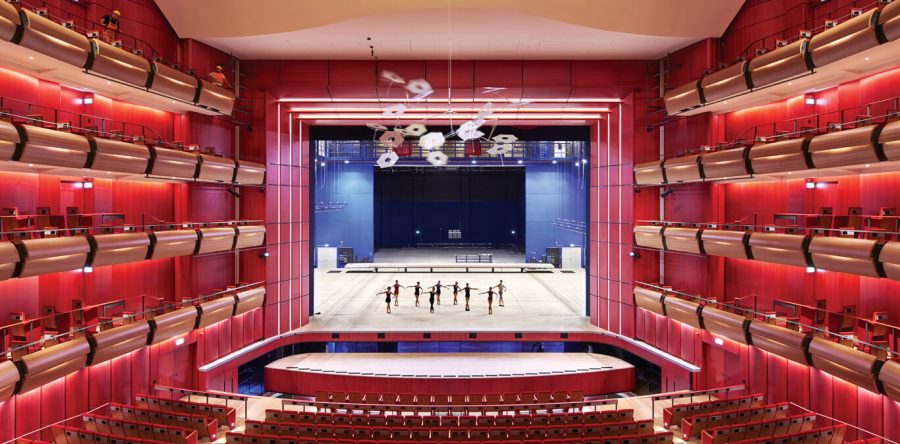
Greek National Opera, SNFCC
The other building adjoining the Opera House, is the National Library, complementing the beautiful neoclassical library in the city centre, which no longer had the capabilities to hold the library’s collection. Renzo Piano used the experience gained from the renovation and expansion of the Public Library of New York, to ensure that a good part of the 750,000 books of the National Library would be visible.
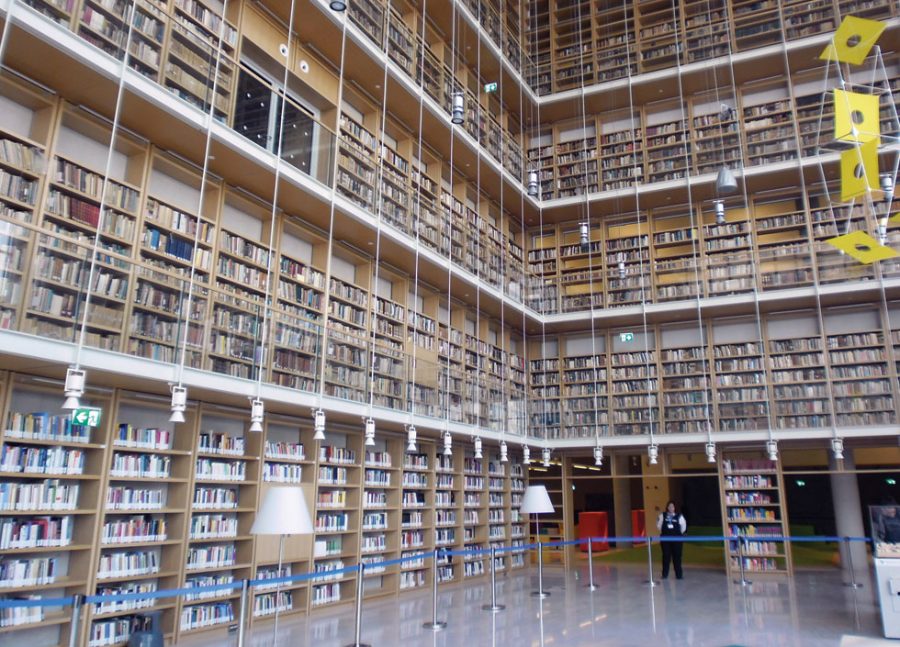
The National Library at the Stavros Niarchos Cultural Foundation – SNFCC
He created a serene space, with Athens’ piercingly clear light filtering in through its massive glass windows. Perched on the bookshelves are prized treasures; in particular an edition of Homer’s ‘Iliad’, dedicated to Napoleon, signed by the Italian printer Giambattista Bodoni. Under the sloping ceiling, which follows the slope of the hill, researchers will be able to study in a vast room reserved just for them. The two buildings thus create a harmonious and peaceful ensemble, capped off by the rooftop garden. Some archaeologists have deemed the creation of this false hill that reverses its natural slope in order to provide a platform for views of the Acropolis, almost a sign of hubris, considered as a crime punishable by the vengeance of the gods in ancient Greece.
This building is at the spiritual axis of the sea, the city and the Acropolis, which gives the impression that our shows are produced for the Gods.”
A beautiful and beneficial legacy
Giorgos Koumendakis is undeniably proud of its magnificent concert and ballet rehearsal rooms, its acoustics and the circular shape of the imposing stage in the main concert hall that seats 1,400 culture lovers. He believes that his mission is also to educate and introduce the Greek public to opera. He will in any case have the financial and technical means to achieve it. A recent donation of 2 million euros from the SNF to the Greek National Opera, will allow for 18 different shows this year. A pledge of confidence, which paradoxically has repelled some artists.
Despite the contribution of the two Foundations being indisputable, there are some differing viewpoints: “It is difficult today to talk about culture in Greece without referring to these two Foundations, but the names Onassis or Niarchos are, for some, symbols of capitalism and the mainstream establishment, which rejects alternative society” notes Muriel Piquet-Viaux, Cultural Attache at the French Embassy in Greece. “This does not prevent them from co-existing, and this is the paradox and beauty of this unconventional and inspiring city for artists. There are nearly 380 theatres in Athens alone, and new artists’ residences keep cropping up. There is a real effervescence.”
The epic rivalry is still alive and well, and the city of Athens remains eternally grateful!
This text first appeared in Le Figaro’s ‘Hors Serie’ special edition on Athens. lefigaro.fr

